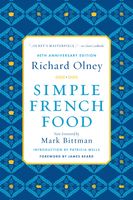Prue Leith's latest book is now on ckbk. Get 25% off ckbk Membership
General Composition
Published 1974
Meat and poultry terrines are all made in pretty much the same way: The tender pieces of meat are left whole or cut into relatively large pieces to lend variety to the texture and are usually marinated (very often in Cognac, which lends a false, slightly rotten, gamey taste and renders the terrine indigestible—a good eau de vie is a valuable flavoring agent but should be incorporated only just before cooking); tougher flesh containing tendons or nervous tissue is chopped and usually combined with a certain amount of blandly flavored meat—veal or pork or both—to form the base of the forcemeat; liver lends smoothness to the texture and support to the egg binding; chopped or cubed pork fat (often about three times as much as the proportions given in any of the following recipes) is incorporated to nourish the forcemeat and prevent its drying out; breadcrumbs are too often not added but, if measured discreetly—about one ounce of crumbs per pound of flesh—so that its presence is imperceptible, it will always lend a gratifying lightness to the body of the terrine; in addition to salt, spices, and herbs, garlic, onion, pistachios, truffles, and the currently fashionable green peppercorns may lend aromatic support. The tender, unripened peppercorns are available tinned, but they are much more interesting in their highly perfumed fresh state; in Paris,
Become a Premium Member to access this page
Unlimited, ad-free access to hundreds of the world’s best cookbooks
Over 150,000 recipes with thousands more added every month
Recommended by leading chefs and food writers
Powerful search filters to match your tastes
Create collections and add reviews or private notes to any recipe
Swipe to browse each cookbook from cover-to-cover
Manage your subscription via the My Membership page
Part of
Advertisement
Related Recipes
-
-
-
-
Related Reference
-
-
-
-
Advertisement



